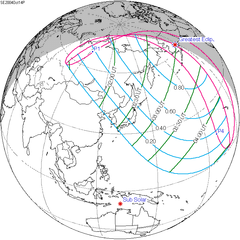October 2013 lunar eclipse
| Penumbral eclipse | |||||||||
 From Washington, D.C., 23:53 UTC | |||||||||
| Date | 18 October 2013 | ||||||||
|---|---|---|---|---|---|---|---|---|---|
| Gamma | 1.1508 | ||||||||
| Magnitude | 0.7649 | ||||||||
| Saros cycle | 117 (52 of 72) | ||||||||
| Penumbral | 239 minutes, 6 seconds | ||||||||
| |||||||||
A penumbral lunar eclipse took place on 18–19 October 2013, the last of three lunar eclipses in 2013.
Visibility

It was visible from the Americas (for the end), Europe, Africa, and most of Asia (the beginning of the eclipse was visible in east Asia). The western part of the Philippines (including western Luzon and Palawan) could see the penumbral eclipse at moonset.
 
|
 Visibility map |
Photo
-
Kennesaw, Georgia, 0:16 UTC
Related eclipses
Eclipses of 2013
- A partial lunar eclipse on 25 April.
- An annular solar eclipse on 10 May.
- A penumbral lunar eclipse on 25 May.
- A penumbral lunar eclipse on 18 October.
- A hybrid solar eclipse on 3 November.
This eclipse is the one of four lunar eclipses in a short-lived series at the descending node of the moon's orbit.
The lunar year series repeats after 12 lunations or 354 days (Shifting back about 10 days in sequential years). Because of the date shift, the Earth's shadow will be about 11 degrees west in sequential events.
| Lunar eclipse series sets from 2013–2016 | ||||||||
|---|---|---|---|---|---|---|---|---|
| Ascending node | Descending node | |||||||
| Saros | Viewing date |
Type | Gamma | Saros | Viewing date |
Type | Gamma | |
112
|
2013 Apr 25
|
Partial
|
−1.0121 | 117
|
2013 Oct 18
|
Penumbral
|
1.1508 | |
122
|
2014 Apr 15
|
Total
|
−0.3017 | 127
|
2014 Oct 08
|
Total
|
0.3827 | |
132
|
2015 Apr 04
|
Total
|
0.4460 | 137
|
2015 Sep 28
|
Total
|
−0.3296 | |
| 142 | 2016 Mar 23
|
Penumbral
|
1.1592 | 147
|
2016 Sep 16
|
Penumbral
|
−1.0549 | |
| Last set | 2013 May 25 | Last set | 2012 Nov 28 | |||||
| Next set | 2017 Feb 11 | Next set | 2016 Aug 18 | |||||
Half-Saros cycle
A lunar eclipse will be preceded and followed by solar eclipses by 9 years and 5.5 days (a half saros).[1] This lunar eclipse is related to two partial solar eclipses of Solar Saros 124.
| 14 October 2004 | 25 October 2022 |
|---|---|

|

|
Tritos series
- Preceded: Lunar eclipse of November 20, 2002
- Followed: Lunar eclipse of September 17, 2024
Tzolkinex
- Preceded: Lunar eclipse of September 6, 2006
- Followed: Lunar eclipse of November 30, 2020
See also
References
- ^ Mathematical Astronomy Morsels, Jean Meeus, p.110, Chapter 18, The half-saros
External links
- 2013 Oct 18 chart: Eclipse Predictions by Fred Espenak, NASA/GSFC
- Hermit eclipse: 23 Mar 2016 – Penumbral Lunar Eclipse
- Eclipse Geeks Penumbra Lunar Eclipse 18/19 October 2013




